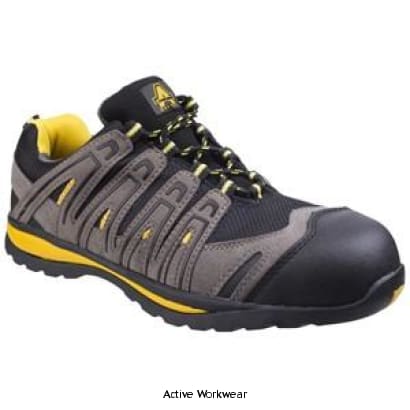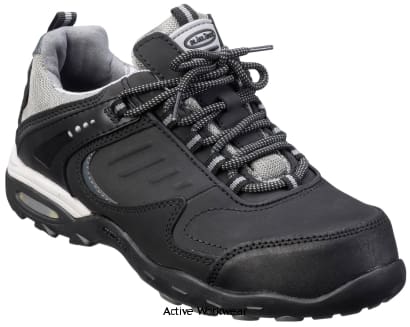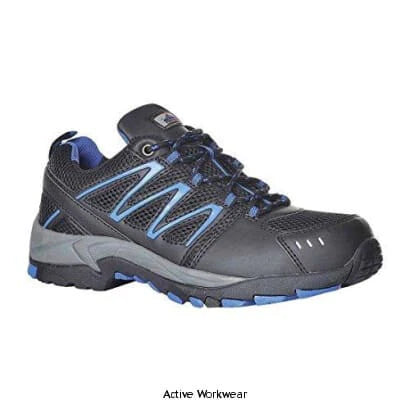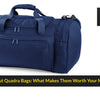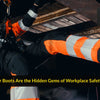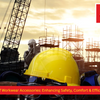The Vital Role of Safety Trainers in Today's Construction Sites
- by Mike Johnson
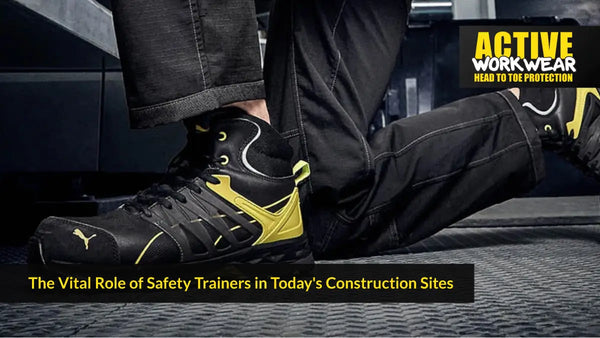
The construction industry is a sector where potential hazards are a daily reality. From the risk of falling objects to the danger of slipping on wet surfaces, construction workers are continually exposed to threats that can lead to severe injuries.
One of the essential elements of personal protective equipment (PPE) for construction workers is safety trainers.
These shoes are specifically designed to protect the feet from various hazards on-site, providing both comfort and safety.
In this article, we'll delve into the importance of safety trainers, how to choose the right pair, and the top safety trainers available at Active Workwear, a leading UK provider of workwear solutions.
Why Safety Trainers Are Essential
Safety trainers play a critical role in protecting workers on construction sites. These shoes are not just about comfort; they're about safeguarding workers' feet from potential hazards that could lead to severe injuries or even permanent disability. Some of the key reasons why safety trainers are indispensable include:
Protection Against Falling and Rolling Objects
Construction sites are filled with heavy equipment and materials that can accidentally fall or roll onto a worker's foot. Safety trainers, particularly those with composite or steel toe caps, can provide essential protection against these hazards.
Prevention of Piercing Injuries
Sharp objects like nails or shards of metal are common on construction sites and can easily pierce through regular footwear, leading to severe foot injuries. Safety trainers are typically built with puncture-resistant soles to protect against such hazards.
Resistance to Slips, Trips, and Falls
Slippery surfaces are a common cause of workplace accidents. Safety trainers usually feature soles with excellent traction, reducing the likelihood of slips, trips, and falls.
Electrical Hazard Protection
For workers dealing with electrical equipment or wiring, electrical hazard safety trainers act as an insulating barrier, preventing electrical currents from passing through the body.
Choosing the Right Safety Trainers
Selecting the right pair of safety trainers is crucial to ensuring maximum protection and comfort on the job. Here are some factors to consider when choosing safety trainers for construction workers:
Evaluate the Work Environment
The type of work and the environment in which you'll be operating should guide your choice of safety shoes. For instance, if workers are regularly dealing with heavy machinery, safety trainers with reinforced toe caps would be ideal.
Similarly, if the worksite is often wet or slippery, shoes with excellent grip and slip resistance would be necessary.
Ensure a Good Fit
Good-fitting shoes are essential for comfort and safety. Shoes that are too tight can cause discomfort and foot problems, while those that are too loose can increase the risk of tripping or turning an ankle.
When selecting safety trainers, make sure they fit well, leaving enough room to move the toes but not so loose that they slip off.
Consider Comfort and Durability
Comfort is crucial when it comes to work footwear since workers often spend long hours on their feet. Features to look for include good arch support, breathable materials, and adequate cushioning.
Durability is also important, as the shoes should withstand the rigours of the worksite. Look for features such as reinforced toe areas and robust construction materials.
Check Safety Ratings
Safety trainers come with different safety ratings, indicating the level of protection they offer. Ensure the trainers meet the necessary safety standards for your industry.
For instance, S1P trainers offer protection against static and provide a certain degree of water resistance, while S3 trainers provide the same protection but also include a puncture-resistant sole.
Top Safety Trainers at Active Workwear
Active Workwear has a range of high-quality safety shoes made for comfort, safety, and lasting use. Whether you work in the building, carpentry, plumbing, or any other trade, you need shoes that can protect your feet from hazards and keep you comfortable throughout the day. Here are some of the top choices you can find.
1. AMBLERS SAFETY FS42C COMPOSITE SAFETY SHOE S1P -20414-32257 42C S1P HRO
This smart safety shoe has a composite toe cap and midsole protection, giving strong safety for your feet. It also has a heat-resistant rubber sole that can handle hot surfaces and sparks. It is made from an airy mesh upper with grey microfibre overlays, giving great comfort and a modern look.
2. BLAKLADER LIGHTWEIGHT SAFETY SHOE COMPOSITE TOE & MIDSOLE S3 SRC - 2429
This light safety shoe from Blaklader has a composite toecap and is made for comfort and lasting use. It also has a new light, heat-resistant, oil-resistant and anti-slip rubber sole that can grip any terrain. The shoe is easy to put on and take off, thanks to the quick-lacing system and the pull loop at the back.
3. STEELITE SAFETY HOT WEATHER SHOE S1P PERFORATED SHOE STEEL TOE AND MIDSOLE - FW02
This low-cut S1P safety shoe from Steelite is ideal for those working in hot places. It has a perforated upper and a special airy lining that keeps your feet cool and dry.
The shoe also has an oil and slip-resistant rubber sole, giving great grip on slippery surfaces. The shoe has a steel toe cap and midsole protection, ensuring your feet are safe from falling objects and sharp items.
4. PORTWEST VISTULA COMPOSITE SAFETY SHOE S1P - FC67
The Vistula composite safety shoe from Portwest is a tough S1P non-metallic hiker, giving comfort and lasting use. It has a specially made outsole that lowers foot tiredness, and its mesh and split leather upper give great airiness and durability. The shoe has a composite toe cap and midsole protection, making it lighter and safer than metal shoes.
6. TOE GUARD WILD LOW ESD S3 SAFETY SHOE -TG80530
The Toe Guard Wild Low is a safety shoe made of PU-coated leather and has a wide fit for the best comfort. The shoe also has a new light, heat-resistant, oil-resistant and anti-slip rubber sole that can handle tough conditions.
The shoe has a composite toe cap and midsole protection and is also ESD certified, meaning it can prevent static electricity build-up.
7. SNICKERS SOLID GEAR HAZE SATURN COMPOSITE SAFETY SHOE -SG80124
The Snickers Solid Gear Haze is a light and comfy S1P safety shoe with composite toecaps. The shoe has an airy, seamless StarKnit upper, and the specially made bounce OrthoLite® insole is mostly made of recycled materials.
The shoe also has a shock-absorbing EVA midsole and a fibreglass shank, giving you stability and flexibility.
Conclusion
Safety trainers play a crucial role in maintaining the safety of construction workers. As such, selecting the right pair is an essential task. At Active Workwear, we offer a wide range of safety trainers for construction workers, all designed to provide the maximum level of protection and comfort. Explore our range today and find the perfect pair to keep you safe on the job.
Remember, your safety is our priority. So, make the right choice and invest in high-quality safety trainers that will protect your feet and enhance your comfort at work.
Addressing FAQs on Safety Trainers
1. What are safety trainers, and why do I need them?
Safety trainers are shoes that are designed to protect your feet from workplace hazards, such as falling objects, sharp items, hot surfaces, or slippery floors. They also provide comfort and support for your feet, especially if you work long hours or often stand. Safety trainers are essential for anyone who works in construction, manufacturing, engineering, or other industries where safety is a priority.
2. How do I choose the right safety trainers for my job?
There are different types of safety trainers, depending on the level of protection and comfort you need. Some of the factors you should consider when choosing safety trainers are:
- The material: Safety trainers can be made of leather, mesh, knit, or other materials. Leather is durable and water-resistant but may not be very breathable. Mesh and knit are more breathable and lightweight but may not be very resistant to water or abrasion.
- The toe cap: Safety trainers can have steel, composite, or alloy toe caps. Steel toe caps are the most protective but also the heaviest and coldest. Composite toe caps are lighter and warmer but may not be as strong as steel. Alloy toe caps are somewhere between, offering a good balance of protection and weight.
- The midsole: Safety trainers can have steel, composite, or EVA midsoles. Steel midsoles are the most protective but also the heaviest and stiffest. Composite midsoles are lighter and more flexible but may not be as strong as steel. EVA midsoles are the most comfortable and shock-absorbing but may not offer much protection from punctures.
- The sole: Safety trainers can have rubber, PU, or TPU soles. Rubber soles are the most slip-resistant, heat-resistant, heaviest, and thickest. PU soles are lighter and thinner but may not be as slip-resistant or heat-resistant as rubber. TPU soles are the most durable and abrasion-resistant but may not be as flexible or cushioning as rubber or PU.
- The certification: Safety trainers can have different certifications, depending on the standards they meet. The most common ones are S1, S1P, S2, S3, and S4. S1 means the shoe has a toe cap and is antistatic. S1P means the shoe has a toe cap and a midsole and is antistatic. S2 means the shoe has a toe cap and is water-resistant and antistatic. S3 means the shoe has a toe cap, a midsole, and a cleated sole and is water-resistant and antistatic. S4 means the shoe is made of rubber or polymer and is waterproof and antistatic.
3. How do I take care of my safety trainers?
Safety trainers are an investment in your safety and comfort, so you should take good care of them to make them last longer. Some of the tips for maintaining your safety trainers are:
- Clean them regularly: You should wipe off dirt or dust from your safety trainers with a damp cloth or a soft brush. You can also use a mild soap and water solution to remove stains or grease. Avoid using harsh chemicals or solvents that may damage the material or the glue.
- Dry them properly: You should let your safety trainers air dry after cleaning or getting them wet. Do not expose them to direct heat or sunlight, which may cause them to crack or fade. You can also stuff them with newspaper or tissue paper to absorb any moisture and keep their shape.
- Store them well: Store your safety trainers in a cool, dry, ventilated place. Avoid keeping them in plastic bags or boxes, which may trap moisture and cause mould or odour. You can also use shoe trees or shoe horns to prevent them from deforming or creasing.
4. How often should I replace my safety trainers?
Safety trainers are designed to protect your feet from workplace hazards, but they also wear out over time. The frequency of replacing your safety trainers depends on several factors, such as:
- The frequency of use: The more you use your safety trainers, the faster they wear out. If you use your safety trainers every day, you may need to replace them every six months or sooner. If you use your safety trainers occasionally, you may be able to extend their lifespan to a year or more.
- The type of work: The kind of work you do also affects how quickly your safety trainers wear out. If you work in harsh or demanding environments, such as construction, mining, or welding, your safety trainers may be exposed to more abrasion, heat, or impact. This may cause them to deteriorate faster than if you work in less hazardous environments, such as office, retail, or hospitality.
- The quality of the shoe: The quality of the shoe also influences how long your safety trainers last. Higher quality shoes are made of better materials and craftsmanship, which makes them more durable and resistant to wear and tear. Lower-quality shoes are made of cheaper materials and may have defects or flaws, which make them more prone to damage and breakage.
5. What are the benefits of wearing safety trainers?
Safety trainers are not only a requirement for some jobs but also a benefit for your health and well-being. Some of the benefits of wearing safety trainers are:
- They prevent injuries: Safety trainers protect your feet from workplace hazards, such as falling objects, sharp items, hot surfaces, or slippery floors. They also reduce the risk of sprains, fractures, cuts, burns, or infections. By wearing safety trainers, you can avoid costly medical bills, lost wages, or permanent disability.
- They improve comfort: Safety trainers provide comfort and support for your feet, especially if you work long hours or stand a lot. They also reduce fatigue, stress, and pain in your feet, ankles, knees, hips, and back. You can improve your posture, performance, and productivity by wearing safety trainers.
- They enhance confidence: Safety trainers also boost your confidence and morale, making you feel more prepared and professional. They also show that you care about your safety and the safety of others. You can improve your image, reputation, and career prospects by wearing safety trainers.

